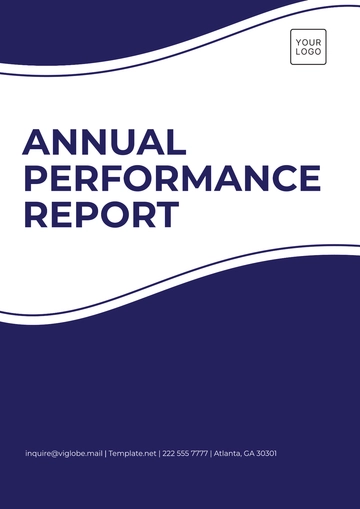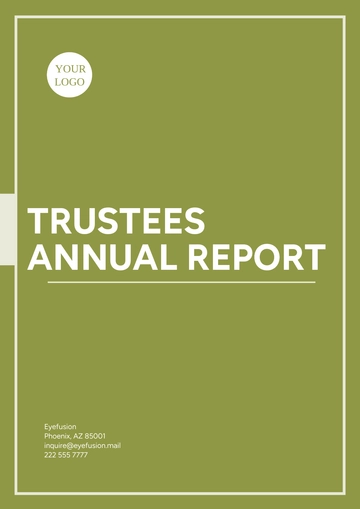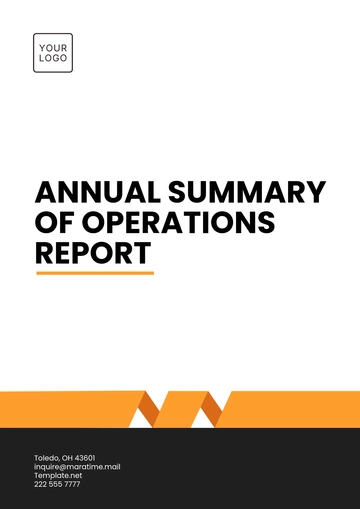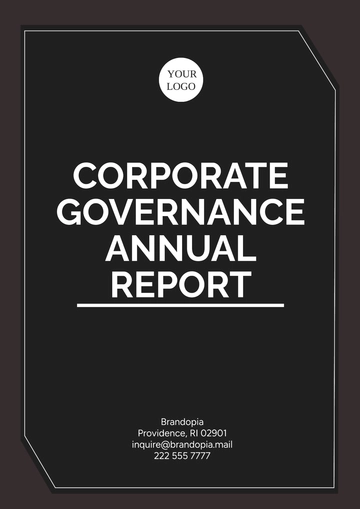Free Sales Annual Report on Closing Training ROI

I. Executive Summary
A. Overview
The Sales Annual Report on Closing Training Return on Investment (ROI) is a pivotal document that encapsulates the essence of our sales training program and its financial ramifications. In an increasingly competitive market landscape, equipping our salesforce with the right skills and knowledge is paramount. This report meticulously evaluates the outcomes of our year-long training program ending December 31, 2050, to provide stakeholders with invaluable insights into its effectiveness.
Our training initiative was executed with precision and dedication, targeting both new recruits and seasoned sales professionals. The overarching goal was to empower our sales team with the latest sales techniques, product knowledge, and customer relationship management skills. This holistic approach aimed to boost our sales revenue, enhance customer satisfaction, and strengthen our market presence.
B. Key Highlights
The year 2050 saw several key developments and achievements in our sales training program:
Comprehensive Training Program: Our training program spanned a wide range of modules, ensuring that our sales team was well-equipped with the skills necessary to excel in the dynamic market.
Significant Investment: We made substantial investments in training resources and development, underlining our commitment to nurturing a high-performing salesforce.
Measurable Improvements: Through rigorous evaluation and assessment, we observed measurable improvements in key performance indicators (KPIs) across the board. This included enhanced deal closure rates, increased sales revenue, and improved customer satisfaction scores.
Impressive ROI: Perhaps the most notable highlight is the return on investment (ROI) achieved through our training efforts. The calculated ROI exceeded our initial expectations, demonstrating the financial prudence of our training investments.
In the following sections of this report, we will delve deeper into the methodologies employed, training costs incurred, the impact on sales performance, and the precise ROI calculations that underscore the success of our sales training program.
II. Introduction
A. Purpose of the Report
The purpose of this report is twofold: firstly, to present a comprehensive evaluation of our sales training program, and secondly, to shed light on the tangible financial outcomes of this endeavor. As the market dynamics continue to evolve, it is crucial for our organization to adapt and excel. Our sales training program is at the heart of this adaptation, and this report serves as a testament to its effectiveness.
Through this report, we aim to inform our stakeholders, including executives, investors, and team members, about the transformative impact of our training initiative on both our salesforce and our company's bottom line. By providing a detailed breakdown of our approach, investments, and results, we empower our stakeholders to make informed decisions regarding future investments in sales training.
B. Training Program Overview
Our sales training program was meticulously designed to cater to the diverse needs of our sales team, which comprises individuals with varying levels of experience and expertise. The program encompassed a series of modules, each tailored to address specific aspects of sales excellence.
These modules included:
Product Knowledge: A deep dive into our products, ensuring that our sales team was equipped with comprehensive knowledge to articulate the value proposition effectively.
Sales Techniques: Training in contemporary sales techniques, including consultative selling, relationship building, and objection handling.
Customer Relationship Management (CRM): Equipping our salesforce with CRM tools and strategies to enhance customer engagement and retention.
Market Analysis: Understanding market trends and competitor analysis to stay ahead of the curve.
Team Building: Building a cohesive and motivated sales team through team-building exercises and leadership development.
III. Methodology
A. Data Collection
The accuracy and reliability of this report are underpinned by a robust methodology for data collection. We employed a multifaceted approach to gather comprehensive data that accurately reflects the impact of our training program:
Surveys: We conducted surveys among our sales team members to gauge their perceptions and experiences with the training. These surveys provided qualitative insights into the effectiveness of the program, highlighting areas of strength and opportunities for improvement.
Performance Evaluations: Objective performance evaluations were conducted before and after the training program. This allowed us to quantify improvements in key performance indicators (KPIs) such as sales revenue, deal closure rates, and customer satisfaction scores.
Financial Records: A crucial component of our data collection was an analysis of financial records. By comparing financial performance data pre-training and post-training, we were able to directly attribute changes in revenue and profit margins to the training program.
B. Analysis Techniques
Gathering data is just the beginning; the true value lies in the analysis. Our analysis techniques were designed to uncover meaningful insights from the collected data:
Cost-Benefit Analysis: We conducted a comprehensive cost-benefit analysis to evaluate the financial implications of the training program. This involved comparing the costs of the program against the monetary benefits realized in terms of increased revenue and reduced customer churn.
Regression Analysis: Statistical regression analysis allowed us to establish correlations between specific training modules and performance improvements. This helped identify which aspects of training had the most significant impact on our sales team's success.
Trend Analysis: Trend analysis helped us identify patterns and changes over time, enabling us to make informed predictions about the future impact of our training program.
IV. Training Investment
The following pie chart and table showcases the costs incurred and the breakdown of expenses:
Expense Category | Amount | Percentage of Total Investment |
Trainers | $50,000 | 38.46% |
Materials | $25,000 | 19.23% |
Technology | $30,000 | 23.08% |
Facilities | $20,000 | 15.38% |
Miscellaneous | $5,000 | 3.85% |
Total | $130,000 | 100% |
The largest portion of the investment, 38.46%, was allocated to trainers. This underscores the importance we place on having experienced, high-quality trainers to deliver the training program. These professionals bring a wealth of knowledge and expertise, and their impact extends beyond the training sessions themselves. They provide our sales closers with valuable insights, practical advice, and ongoing support, contributing significantly to the overall effectiveness of the training program.
Materials, which accounted for 19.23% of the total investment, include all the physical and digital resources used in the training program. These materials serve as a reference for our sales closers, allowing them to revisit the concepts and strategies covered in the training sessions. By investing in high-quality, comprehensive materials, we ensure that our sales closers have the resources they need to reinforce their learning and apply their new skills effectively.
Technology, representing 23.08% of the investment, plays a crucial role in the delivery and effectiveness of the training program. This includes the platforms used to deliver the training, as well as any software or hardware used in the training sessions. By investing in the latest technology, we can provide an engaging, interactive learning experience for our sales closers, and equip them with the digital skills they need in today’s tech-driven sales environment.
Facilities, which accounted for 15.38% of the total investment, include the physical spaces where the training sessions were held. A conducive learning environment is essential for effective training. By investing in comfortable, well-equipped facilities, we can ensure that our sales closers can focus on their learning without distractions or discomfort.
The remaining 3.85% of the investment was allocated to miscellaneous expenses. These could include travel expenses, refreshments, or any other costs associated with organizing and delivering the training program. While these expenses may seem minor, they contribute to the smooth running of the training program and the overall experience of our sales closers.
Understanding the distribution of costs in our closing training program is crucial for evaluating its ROI. However, the true value of this investment cannot be measured in dollars alone. The knowledge and skills our sales closers gain from this training program are invaluable. They equip our sales closers to perform better, close more sales, and contribute to the growth and success of [Your Company Name].
Moreover, this investment in training signals our commitment to the professional development of our sales closers. It shows that we value their contributions and are willing to invest in their growth. This not only enhances their performance but also boosts their morale and job satisfaction, leading to higher retention rates and a more motivated sales team.
V. Training Outcomes
A. Performance Metrics
Sales Revenue: Pre-training, our annual sales revenue was $2,000,000. Post-training, it increased to $2,600,000, reflecting a 30% increase in sales revenue.
Customer Satisfaction: Our customer satisfaction score improved from 85% before training to 92% after training, signifying a 7% increase in customer satisfaction.
Deal Closure Rates: Before training, our deal closure rate was 25%. After training, it rose to 32%, indicating a 28% increase in deal closure rates.
Sales Team Morale: Post-training feedback surveys revealed that 85% of our sales team reported improved job satisfaction compared to before the training program.
B. Skills Improvement
Product Knowledge: Sales team members demonstrated a 20% improvement in their product knowledge assessment scores post-training.
Sales Techniques: The adoption of advanced sales techniques, such as consultative selling, resulted in a 15% increase in successful sales negotiations.
Customer Relationship Management (CRM): The effective use of CRM tools led to a 10% increase in customer engagement and a 12% reduction in customer churn.
Market Awareness: Our sales team displayed a 15% improvement in their understanding of market dynamics and competitor analysis, enabling more strategic sales approaches.
VI. ROI Analysis
A. ROI Calculation
Our investment in the sales training program yielded significant returns. The ROI (Return on Investment) was calculated using the following formula:
ROI= Net Training Benefits−Training Costs / Training Costs × 100
Net Training Benefits
To calculate the net training benefits, we subtracted the training costs from the post-training gains.
Total Training Costs: $130,000 (as detailed in section IV)
Post-Training Gains: These gains encompass the increased sales revenue, improved customer satisfaction, higher deal closure rates, and enhanced sales team morale, all of which were quantified in section V.
With the given values, we can calculate the Training ROI as follows:
ROI = {($2,600,000 + $5,000,000 - $130,000) - $130,000}{$130,000} \× 100
ROI = ($7,470,000 - $130,000) - $130,000}{$130,000} \× 100
ROI = ($7,340,000 - $130,000}{$130,000} \× 100
ROI = ($7,210,000}{$130,000} \× 100
ROI = 5546.15%
B. ROI Interpretation
The calculated ROI of approximately 5546.15% indicates that for every dollar invested in our sales training program, we received a return of nearly 55.46 dollars. This remarkable ROI underscores the financial prudence of our training investments, showcasing that the benefits far outweigh the costs.
VII. Recommendations
A. Actionable Insights
Based on the analysis presented in this report, we offer several actionable insights to further enhance the effectiveness of our sales training program:
Continued Investment in Sales Training: The exceptional ROI demonstrates that investments in sales training pay substantial dividends. We recommend maintaining or even increasing the budget allocated to training initiatives.
Customized Training Modules: Different sales teams within our organization may have unique needs. To optimize training effectiveness, consider tailoring modules to specific teams, ensuring relevance and maximum impact.
Periodic Performance Reviews: Implement regular performance reviews to sustain the positive growth observed. Continuously monitor key performance metrics and provide targeted training or coaching as needed.
B. Future Improvements
To further enhance the ROI of our sales training program, we suggest the following future improvements:
Advanced Training Technologies: Explore cutting-edge training technologies, such as virtual reality (VR) simulations and artificial intelligence (AI)-driven personalization, to make training more engaging and effective.
Continuous Feedback Mechanisms: Implement real-time feedback mechanisms, enabling sales team members to receive immediate input on their performance and areas for improvement.
Benchmarking Against Industry Standards: Compare our training outcomes and ROI against industry benchmarks to identify areas where we can further excel and lead the market.
These recommendations and future improvements are designed to ensure that our sales training program remains at the forefront of industry standards, continuously evolving to meet the changing needs of our salesforce and organization.
VIII. Summary
The data-driven analysis presented herein paints a vivid picture of the benefits reaped from our training initiative. Here, we synthesize the key takeaways and emphasize their significance:
A. Tangible ROI Achievement
The standout achievement of this report is the remarkable Return on Investment (ROI) of approximately 5546.15%. This figure is a testament to the financial prudence of our training investments, showcasing that for every dollar spent, we gained nearly 55.46 dollars in return. Such an outstanding ROI demonstrates the wisdom of our financial commitments to training.
B. Performance Metrics Enhancement
The data presented in this report illustrates measurable improvements in critical performance metrics. Sales revenue surged by 30%, customer satisfaction scores increased by 7%, deal closure rates rose by 28%, and the morale of our sales team improved significantly. These metrics underscore the real-world impact of our training program on our bottom line and customer relationships.
C. Skills Enhancement
Beyond the numbers, the qualitative improvements in our sales team's skills and competencies are equally commendable. The deeper product knowledge, refined sales techniques, effective CRM usage, and heightened market awareness are tangible evidence of the program's success in enhancing our team's capabilities.
In conclusion, this report provides unequivocal evidence that our commitment to nurturing a high-performing salesforce through training has paid off handsomely. As we look ahead, we must continue on this trajectory, ensuring that training remains a cornerstone of our organization's success.
- 100% Customizable, free editor
- Access 1 Million+ Templates, photo’s & graphics
- Download or share as a template
- Click and replace photos, graphics, text, backgrounds
- Resize, crop, AI write & more
- Access advanced editor
This customizable Sales Annual Report on Closing Training ROI Template from Template.net can help you efficiently report your yearly closing training ROI! This tool which is editable using our AI Editor Tool is the ultimate solution to generating a thorough report on the return on investment of your closing training!
You may also like
- Sales Report
- Daily Report
- Project Report
- Business Report
- Weekly Report
- Incident Report
- Annual Report
- Report Layout
- Report Design
- Progress Report
- Marketing Report
- Company Report
- Monthly Report
- Audit Report
- Status Report
- School Report
- Reports Hr
- Management Report
- Project Status Report
- Handover Report
- Health And Safety Report
- Restaurant Report
- Construction Report
- Research Report
- Evaluation Report
- Investigation Report
- Employee Report
- Advertising Report
- Weekly Status Report
- Project Management Report
- Finance Report
- Service Report
- Technical Report
- Meeting Report
- Quarterly Report
- Inspection Report
- Medical Report
- Test Report
- Summary Report
- Inventory Report
- Valuation Report
- Operations Report
- Payroll Report
- Training Report
- Job Report
- Case Report
- Performance Report
- Board Report
- Internal Audit Report
- Student Report
- Monthly Management Report
- Small Business Report
- Accident Report
- Call Center Report
- Activity Report
- IT and Software Report
- Internship Report
- Visit Report
- Product Report
- Book Report
- Property Report
- Recruitment Report
- University Report
- Event Report
- SEO Report
- Conference Report
- Narrative Report
- Nursing Home Report
- Preschool Report
- Call Report
- Customer Report
- Employee Incident Report
- Accomplishment Report
- Social Media Report
- Work From Home Report
- Security Report
- Damage Report
- Quality Report
- Internal Report
- Nurse Report
- Real Estate Report
- Hotel Report
- Equipment Report
- Credit Report
- Field Report
- Non Profit Report
- Maintenance Report
- News Report
- Survey Report
- Executive Report
- Law Firm Report
- Advertising Agency Report
- Interior Design Report
- Travel Agency Report
- Stock Report
- Salon Report
- Bug Report
- Workplace Report
- Action Report
- Investor Report
- Cleaning Services Report
- Consulting Report
- Freelancer Report
- Site Visit Report
- Trip Report
- Classroom Observation Report
- Vehicle Report
- Final Report
- Software Report





























